Intel Ghost Canyon NUC9i9QNX Review: NUC 9 Extreme Realizes the SFF Dream
by Ganesh T S on April 16, 2020 8:05 AM ESTMiscellaneous Performance Metrics
This section looks at some of the other commonly used benchmarks representative of the performance of specific real-world applications.
3D Rendering - CINEBENCH R15
We use CINEBENCH R15 for 3D rendering evaluation. The program provides three benchmark modes - OpenGL, single threaded and multi-threaded. Evaluation of different PC configurations in all three modes provided us the following results.
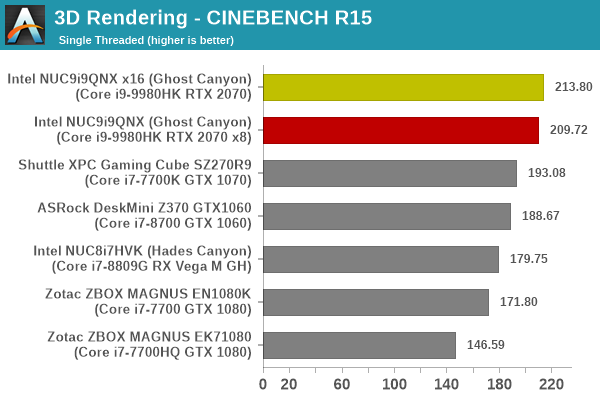
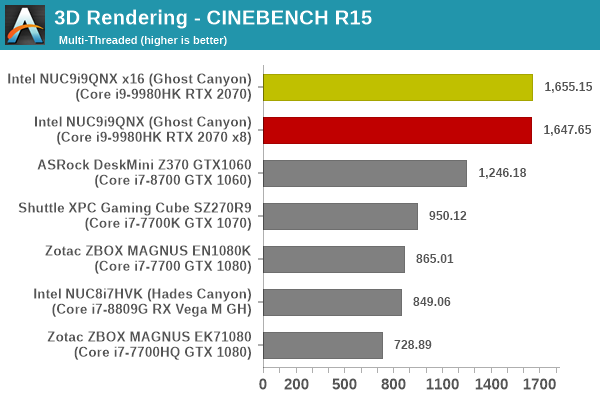
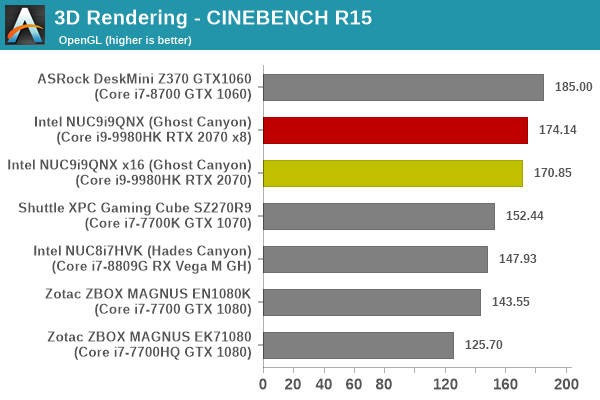
The results track what was observed in the media and entertainment category workloads in SPECworkstation 3.
x265 Benchmark
Next up, we have some video encoding benchmarks using x265 v2.8. The appropriate encoder executable is chosen based on the supported CPU features. In the first case, we encode 600 1080p YUV 4:2:0 frames into a 1080p30 HEVC Main-profile compatible video stream at 1 Mbps and record the average number of frames encoded per second.
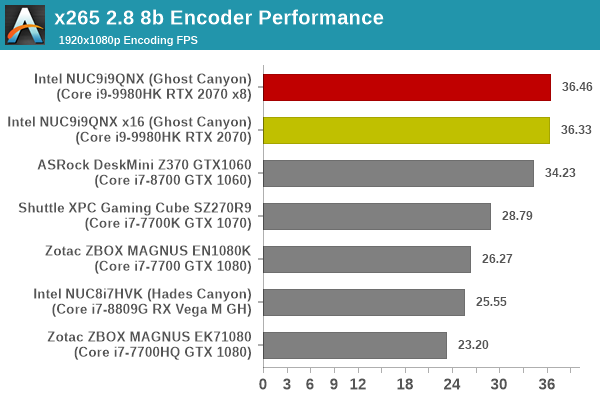
Our second test case is 1200 4K YUV 4:2:0 frames getting encoded into a 4Kp60 HEVC Main10-profile video stream at 35 Mbps. The encoding FPS is recorded.
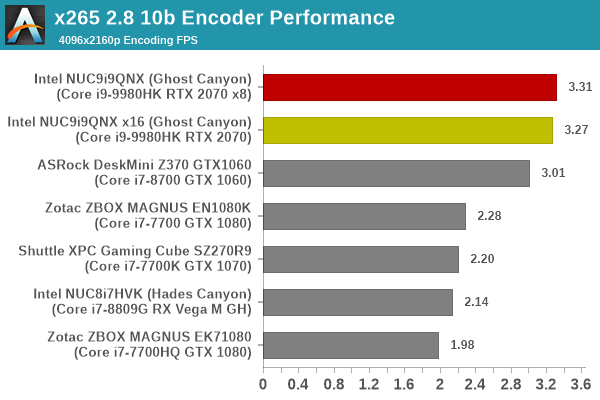
The Ghost Canyon NUC surprisingly performs better than systems equipped with CPUs sporting much higher TDPs.
7-Zip
7-Zip is a very effective and efficient compression program, often beating out OpenCL accelerated commercial programs in benchmarks even while using just the CPU power. 7-Zip has a benchmarking program that provides tons of details regarding the underlying CPU's efficiency. In this subsection, we are interested in the compression and decompression rates when utilizing all the available threads for the LZMA algorithm.
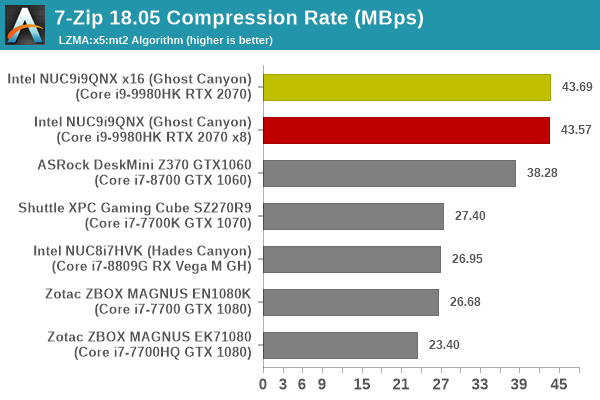
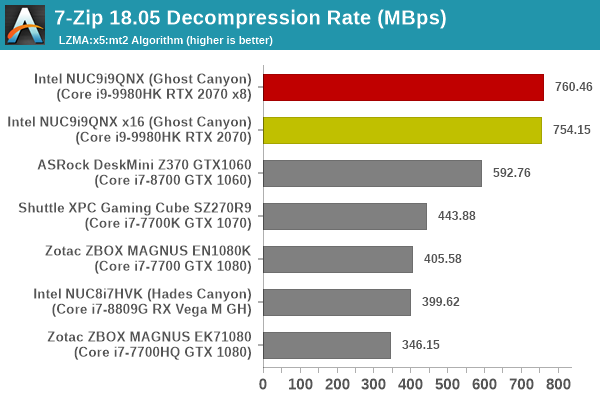
Given the brief nature of the benchmark workload and the large number of available threads, it is no surprise that the Ghost Canyon NUC performs significantly better than the rest of the systems in this workload.
Cryptography Benchmarks
Cryptography has become an indispensable part of our interaction with computing systems. Almost all modern systems have some sort of hardware-acceleration for making cryptographic operations faster and more power efficient. In this sub-section, we look at two different real-world applications that may make use of this acceleration.
BitLocker is a Windows features that encrypts entire disk volumes. While drives that offer encryption capabilities are dealt with using that feature, most legacy systems and external drives have to use the host system implementation. Windows has no direct benchmark for BitLocker. However, we cooked up a BitLocker operation sequence to determine the adeptness of the system at handling BitLocker operations. We start off with a 2.5GB RAM drive in which a 2GB VHD (virtual hard disk) is created. This VHD is then mounted, and BitLocker is enabled on the volume. Once the BitLocker encryption process gets done, BitLocker is disabled. This triggers a decryption process. The times taken to complete the encryption and decryption are recorded. This process is repeated 25 times, and the average of the last 20 iterations is graphed below.


The BitLocker benchmark results are a bit surprising, particularly given the clear performance benefits of the Core i9-9980HK for cryptography applications in the other applications below.
Creation of secure archives is best done through the use of AES-256 as the encryption method while password protecting ZIP files. We re-use the benchmark mode of 7-Zip to determine the AES256-CBC encryption and decryption rates using pure software as well as AES-NI. Note that the 7-Zip benchmark uses a 48KB buffer for this purpose.

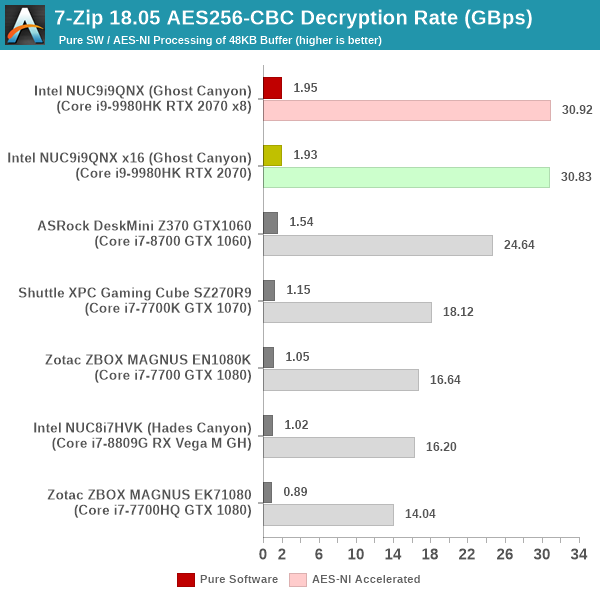
As expected, the 8C/16T configuration allows for fast encryption and decryption irrespective of the use of pure software or AES-NI instructions.
Yet another cryptography application is secure network communication. OpenSSL can take advantage of the acceleration provided by the host system to make operations faster. It also has a benchmark mode that can use varying buffer sizes. We recorded the processing rate for a 8KB buffer using the hardware-accelerated AES256-CBC-HAC-SHA1 feature.
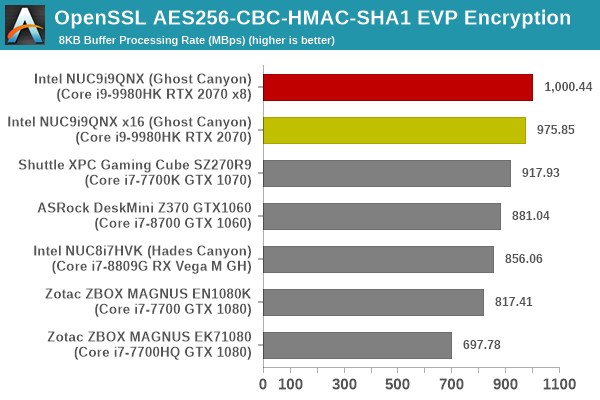

These results are not surprising given the core count and operating frequency profile of the CPU in the Ghost Canyon NUC.
Agisoft Photoscan
Agisoft PhotoScan is a commercial program that converts 2D images into 3D point maps, meshes and textures. The program designers sent us a command line version in order to evaluate the efficiency of various systems that go under our review scanner. The command line version has two benchmark modes, one using the CPU and the other using both the CPU and GPU (via OpenCL). We present the results from our evaluation using the CPU mode only. The benchmark (v1.3) takes 84 photographs and does four stages of computation:
- Stage 1: Align Photographs (capable of OpenCL acceleration)
- Stage 2: Build Point Cloud (capable of OpenCL acceleration)
- Stage 3: Build Mesh
- Stage 4: Build Textures
We record the time taken for each stage. Since various elements of the software are single threaded, and others multithreaded, it is interesting to record the effects of CPU generations, speeds, number of cores, and DRAM parameters using this software.
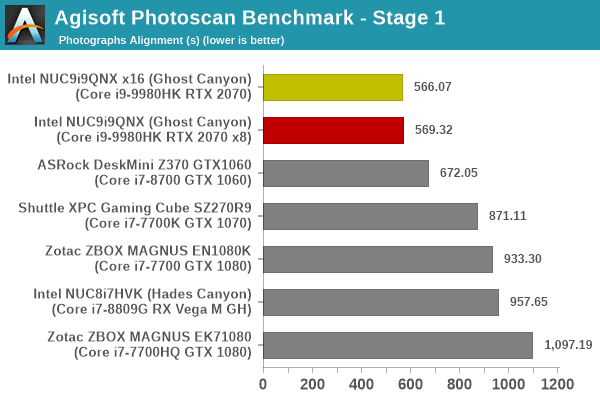
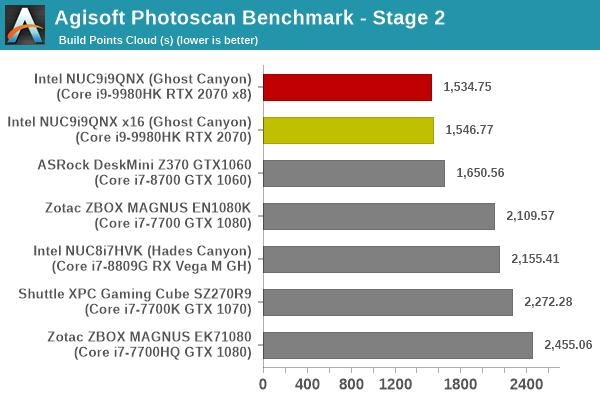
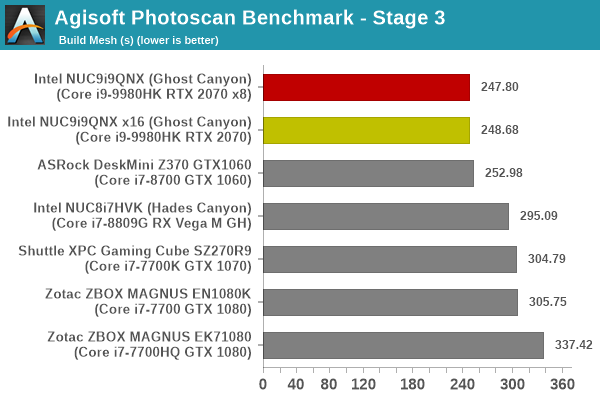
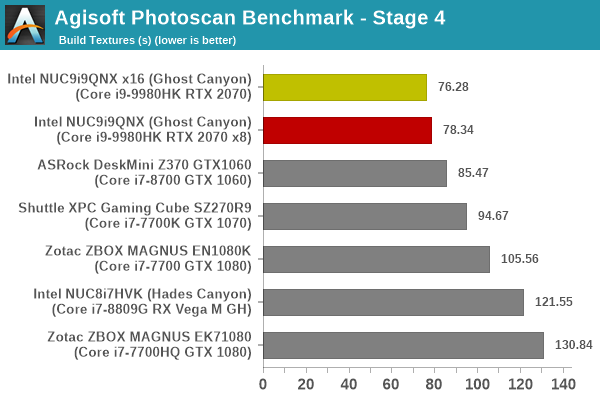
The Ghost Canyon NUC is better than any of the other considered systems across all Photoscan stages.
Dolphin Emulator
Wrapping up our application benchmark numbers is the new Dolphin Emulator (v5) benchmark mode results. This is again a test of the CPU capabilities.

In fact, the 249s taken by the Ghost Canyon NUC is the fastest amongst all SFF PCs we have evaluated with this benchmark.










109 Comments
View All Comments
timecop1818 - Thursday, April 16, 2020 - link
Really bad selection of pictures. Did you not actually have a unit with you when reviewing? There's no external shots, there's no pics of the board/GPU connected together, there's no pics of rear backplane with ports/whatever, basically no useful info. I clicked through the gallery and I have no idea how big this thing is, or how the GPU fits into the picture, or anything else. Even "setup notes" page shows nothing useful.DanNeely - Thursday, April 16, 2020 - link
The chassis gallery on the 1st page shows the fully assembled system with the rear IO ports visible and gives a decent visual idea of how big the system is.timecop1818 - Thursday, April 16, 2020 - link
Oh hey, I see the stuff now. There's separate galleries throughout the article, for some reason I thought there was only one per page, and the 1st page only showed disassembled cpu module so I thought that was it. Thanks for pointing it out.FireSnake - Thursday, April 16, 2020 - link
Based on this:https://www.notebookcheck.net/AnandTech-editor-rep...
they are not getting any money from me!
For a loooong looong time (those includd too).
bug77 - Thursday, April 16, 2020 - link
It's a good thing you don't get hung up on details like proof and stuff. Guilty until proven innocent, eh? (And yes, I know history doesn't work in their favor.)DigitalFreak - Thursday, April 16, 2020 - link
Ian doesn't seem like the person to throw around baseless accusations.ganeshts - Thursday, April 16, 2020 - link
The tweet has been misinterpreted and now taken a completely unintended shape of its own. Ian plans to clarify the usage of the word 'incentive' in the context in an upcoming video / post.FWIW, if anyone believe AMD doesn't offer incentives to its partners (of a type similar to what Intel does, and what is completely legal), then the person has no idea of how the technology industry / silicon vendors operate.
If anyone thinks the reason for lack of high-performance AMD-based (read, Renoir) 'NUC's is Intel, then I have a bridge to sell. No one is preventing AMD from creating a reference design for a Renoir-based 4x4 board or innovate with Compute Element-like products. OEMs can take the plunge only if the silicon vendors offer them a proof of concept. If a Renoir NUC reference design exists, but OEMs still don't pick it up to offer them in the market, that would be worthy of deeper investigation (that could still throw up legitimate reasons).
Namisecond - Friday, April 17, 2020 - link
Even when reference designs exist, availability of parts can come into play, or even OEM disinterest.quadrivial - Friday, April 17, 2020 - link
AMD has reference designs and an entire set of embedded Zen 1 chips made explicitly for that purpose. Udoo Bolt was kickstarted by a fairly small company. If they could do it, why not bigger companies?arashi - Saturday, April 18, 2020 - link
You must understand that Intel PR and legal has been in touch.